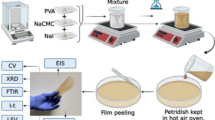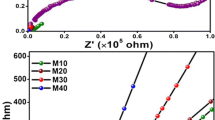Abstract
Transparent thin film polymer electrolytes were prepared by solvent casting technique with the doping of environmental-friendly ionic liquid, 1-allyl-3-methylimidazolium chloride ([Amim] Cl) into the matrix formed by cellulose acetate (CA) and lithium bis(trifluoromethanesulfonyl)imide (LiTFSI). The ionic conducting nature of this system improves significantly from the order of 10−7–10−2 S cm−1 upon increasing doping of [Amim] Cl content till a maximum of 4.68 × 10−2 S cm−1 is attained for the composition CA:LiTFSI:[Amim] Cl (14:6:80 wt%). The improving trend in ionic conductivity results from the bond weakening between the connecting atoms in the crystalline region that induces to the increase in amorphous counterpart fractions in the CA matrix. This observation was proved via the accountancies in the reduction of relative viscosity, root mean square value and increase in void as increase in [Amim] Cl doping. The resultant phase conversion hence permits immense lithium ion (Li+) fluidity along the polymer backbone and assisting the improvement in ionic conductivity. The thin film polymer electrolyte is found to be elastic in the presence of crystalline fraction and radically deforms upon the chains diffusion into the amorphous fraction. The linear curvatures of the Arrhenius plot justify the conductivity improvement as via the increasing frequency of Li+ ions hopping as the temperature increases. The increasing addition of [Amim] Cl diminishes both the heat-resistivity and thermal stability of CA:LiTFSI:[Amim] Cl matrix.






Similar content being viewed by others
References
Averous L, Fringant C, Moro L (2001) Plasticized starch–cellulose interactions in polysaccharide composites. Polymer 42:6565–6572. doi:10.1016/S0032-3861(01)00125-2
Cho M, Seo H, Nam J, Choi H, Koo J, Lee Y (2007) High ionic conductivity and mechanical strength of solid polymer electrolytes based on NBR/ionic liquid and its application to an electrochemical actuator. Sens Actuators B Chem 128:70–74. doi:10.1016/j.snb.2007.05.032
Cuissinat C, Navard P, Heinze T (2008) Swelling and dissolution of cellulose. Part IV: free floating cotton and wood fibres in ionic liquids. Carbohydr Polym 72:590–596. doi:10.1016/j.carbpol.2007.09.029
Kubisa P (2004) Application of ionic liquids as solvents for polymerization processes. Prog Polym Sci 29:3–12. doi:10.1016/j.progpolymsci.2003.10.002
Mano JF, Koniarova D, Reis RL (2003) Thermal properties of thermoplastic starch/synthetic polymer blends with potential biomedical capability. J Mater Sci Mater Med 14:127–135. doi:10.1023/A:1022015712170
Mohamad AA, Arof AK (2007) Plasticized alkaline solid polymer electrolyte system. Mater Lett 61:3096–3099. doi:10.1016/j.matlet.2006.11.030
Ning W, Xingxiang Z, Haihui L, Benqiao H (2009) 1-Allyl-3-methylimidazolium chloride plasticized-corn starch as solid biopolymer electrolytes. Carbohydr Polym 76:482–484. doi:10.1016/j.carbpol.2008.11.005
Paradhan DK, Choundhary RNP, Samantaray BK (2008) Studies of dielectric relaxation and AC conductivity behavior of plasticized polymer nanocomposite electrolytes. Int J Electrochem Sci 3:597–608. doi:10.1016/j.matchemphys.2009.01.008
Ramesh S, Lu SC (2008) Effect of nanosized silica in poly (methyl methacrylate)-lithium bis(trifluoromethanesulfonyl)imide based polymer electrolytes. J Power Sour 185:1439–1443. doi:10.1016/j.jpowsour.2008.07.055
Ramesh S, Yahya AH, Arof AK (2002) Dielectric behavior of PVC based polymer electrolytes. Solid State Ion 152–153:291–294. doi:10.1016/S0167-2738(02)00311-9
Ramesh S, Liew CW, Morris E, Durairaj R (2010) Effect of PVC on ionic conductivity, crystallographic structural, morphological and thermal characterizations in PMMA PVC blend-based polymer electrolytes. Thermochim Acta 511:140–146. doi:10.1016/j.tca.2010.08.005
Ramesh S, Shanti R, Durairaj R (2011) Effect of ethylene carbonate in poly (methyl methacrylate)-lithium tetraborate based polymer electrolytes. J Non-Cryst Solids 357:1357–1363. doi:10.1016/j.jnoncrysol.2010.09.021
Selvakumar M, Krishna Bhat D (2008) LiClO4 doped cellulose acetate as biodegradable polymer electrolyte for supercapacitors. J Appl Polym Sci 110:594–602. doi:10.1002/app.28671
Sharma JP, Sekhon SS (2007) Nanodispersed polymer gel electrolytes: conductivity modification with the addition of PMMA and fumed silica. Solid State Ion 178:439–445. doi:10.1016/j.ssi.2007.01.017
Sing B, Sekhon SS (2005) Ion conducting behaviour of polymer electrolytes containing ionic liquids. Chem Phys Lett 414:34–39. doi:10.1016/j.cplett.2005.08.046
Swatloski RP, Spear SK, Holbrey JD, Rogers RD (2002) Dissolution of cellulose with ionic liquids. J Am Chem Soc 124:4974–4975. doi:10.1021/ja025790m
Tang Z, Qi L, Gao G (2008) Dynamic mechanical properties of gel polymer electrolytes containing ionic liquid. Solid State Ion 179:1880–1884. doi:10.1016/j.ssi.2008.05.011
Welton T (1999) Room-temperature ionic liquids. Solvents for synthesis and catalysis. Chem Rev 99:2071–2084. doi:10.1021/cr980032t
Wu RL, Wang XL, Li F, Li HZ, Wang YZ (2009) Green composite films prepared from cellulose, starch and lignin in room-temperature ionic liquid. Bioresour Technol 100:2569–2574. doi:10.1016/j.biortech.2008.11.044
Yahya MZA, Arof AK (2003) Effect of oleic acid plasticizer on chitosan–lithium acetate solid polymer electrolytes. Eur Polym J 39:897–902. doi:10.1016/S0014-3057(02)00355-5
Yahya MZA, Ali AMM, Mohammat MF, Hanafiah MAKM, Mustaffa M, Ibrahim SC, Darus ZM, Harun MK (2006) Ionic conduction model in salted chitosan membranes plasticized with fatty acid. J Appl Sci 6:1287–1291. doi:10.3923/jas.2006.1287.1291
Acknowledgments
This work was supported by the High Impact Research Grant (J-21002-73851) from University of Malaya. The co-author named R. Shanti gratefully acknowledges the “Skim Bright Sparks University Malaya (SBSUM)” for the financial support.
Author information
Authors and Affiliations
Corresponding author
Rights and permissions
About this article
Cite this article
Ramesh, S., Shanti, R. & Morris, E. Employment of [Amim] Cl in the effort to upgrade the properties of cellulose acetate based polymer electrolytes. Cellulose 20, 1377–1389 (2013). https://doi.org/10.1007/s10570-013-9919-1
Received:
Accepted:
Published:
Issue Date:
DOI: https://doi.org/10.1007/s10570-013-9919-1




